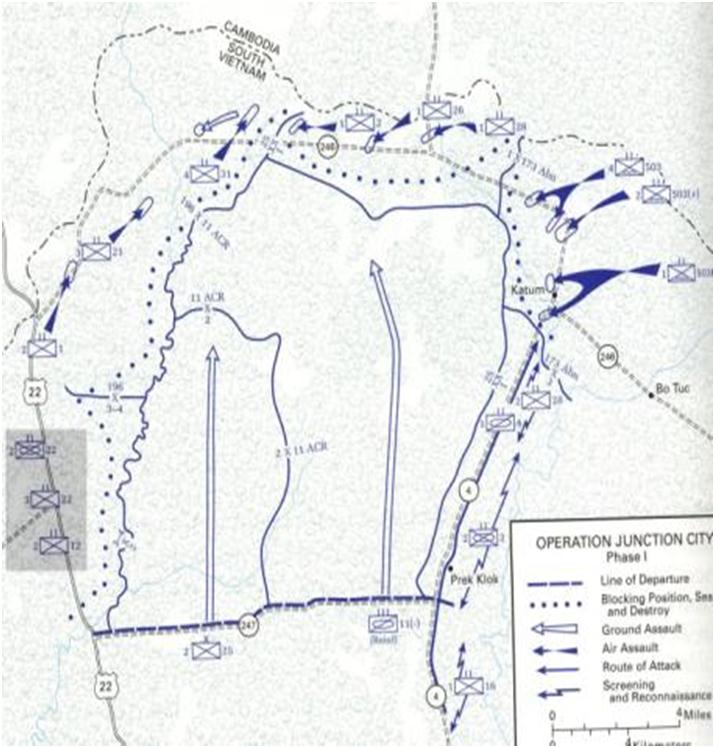Operation Junction City
This was an 82-day military operation conducted by United States and Republic of Vietnam (RVN or South Vietnam) forces begun on 22 February 1967 during the Vietnam War. It was the largest U.S. airborne operation since Operation Market Garden during World War II, the only major airborne operation of the Vietnam War, and one of the largest U.S. operations of the war.
Operation Feb 22 to May 14, 1967
Junction City was a massive search and destroy operation, conducted in hopes of clearing People's Army of Vietnam (PAVN) and Viet Cong units from the area of War Zone C, northwest of Saigon. Another goal of the operation was the possible capture or destruction of the PAVN/NLF Central Office for South Vietnam (COSVN). This headquarters controlled all enemy activities south of the tri-border region of Laos, Cambodia, and South Vietnam.
The operation was considered largely successful by the U.S. command, although PAVN/NLF units returned to the area once allied forces withdrew. COSVN itself withdrew to the safety of Cambodian territory, where it remained for the rest of the U.S. commitment to the Vietnam War. The operation's failure in destroying the COSVN according to Major General John Hay was due to three main factors. These included the proximity of a sanctuary to reported COSVN locations, difficulty in achieving sufficient troop density to infiltrate the Viet Cong and the failure to gain complete surprise through the repositioning of U.S. troops. On 22 February 1967, the 173rd ABN Bde conducted the only combat parachute jump of the Vietnam War.The operation saw three brigades controlling eight battalions dropped by helicopters and US Air Force aircraft into War Zone C, in Tay Ninh Province.[30] During the battle, the Brigade operated out of the northeastern part of the war zone along with the 196th Infantry Brigade (Separate), as four other brigades from the 1st and 25th Infantry Divisions attempted to surround and destroy the 9th Viet Cong Division in the War Zone. Major General Tran Do of PAVN later recalled that, in addition to being unable to find the Central Office, the United States Army "got soundly trounced, having up to about 1,000 tanks and armored vehicles destroyed. In the end, they had to withdraw their forces from these areas, reaping no success at all."[1] The failure to gain surprise lay in discovery of the plans after NVA Col. Dinh Thi Van managed to place one of her agents in social circles that included ARVN Gen. Cao Van Vien and US Gen. William Westmoreland. That agent further reported one ARVN staff officer's comment of the early phase of the operation: "(The Viet Cong) seem like ghosts. All the six spearheads of our forces have been attacked while we don't know exactly where their main force is. Even in Bau Hai Vung that is considered to be a safe area, we lost one brigade. It's so strange." (Van, p. 237)
Units involved in this operation included:
2/11th ACR
1,2,4th 503rd 173st ABN
¾ Cav
4/31Inf 196th LIB
2/1 Inf 196th LIB
3/21Inf 196th LIB
3/22 Inf 4th Div
2/22 (M) 4th Div
2/12 4th Div
1/2 1st Div
1/18 1st Div
2/2 (M) 1st Div
1, 2/16 1st Div
Unit Locations during execution of Junction City. Circles represent aerial assaults.



